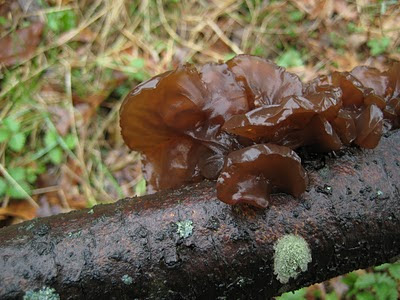and the rain came in from the wide blue yonder
~ from the song Coma Girl
by Joe Strummer and the Mescaleros
On this day of torrential rainfall, I suppose it’s natural for thoughts to turn to . . . fungi.
Setting aside plant roots, fungi constitute some 90 percent of the biomass of forest soil, release huge amount of carbon dioxide into the atmosphere as they do their work on dead wood, give that rise to bread and that kick to beer and wine, aid us with antibiotics, and, until recently, I have to admit, mostly went unnoticed as I traipsed through the woods to a fossil site or shepherded my dog on a walk along a woodland trail.
Frankly, I’m surprised it took so long for the fantastically complex Fungi Kingdom to really register with me. I mean my usual posture in the field is certainly appropriate – head down, eyes scanning the ground. (Of course, I’ve been looking for the telltale signs of fossilized tooth or bone.)
Further, one of my favorite naturalists, Beatrix Potter, was a mycologist, producing aesthetically pleasing and scientifically accurate drawings of fungi. This gloomy, dreary day is a perfect moment to have a cuppa and read about Potter or reread one of her children’s tales.
In a previous post, I’ve touched on Potter’s rebuff by the British scientific community when she dared to assert herself on scientific matters involving fungi. Excluding the summary dismissal by the establishment that essentially concludes the story of her scientific endeavors with fungi, it’s an uplifting account of a shy woman in her late 20s reaching out and connecting over fungi with an older, withdrawn, and eccentric mycologist. Scotsman Charles McIntosh was someone the Potter family knew from vacations in Scotland. He worked as a postman but the self-taught naturalist was a renowned expert on fungi, consulted by botanists and mycologists from throughout Britain. Potter and McIntosh had a truly symbiotic relationship, she drew pictures of the specimens that he sent her, he shared his knowledge, identifying specimens she found. The two exchanged thoughts and insights on the fungal lifecycle.
In her journal entry of October 29, 1892, Potter described him this way with her usual wit,
When one met him, a more scared startled scarecrow it would be difficult to imagine. . . . He was quite painfully shy and uncouth at first, as though he was trying to swallow a muffin . . . . (p. 82, Beatrix Potter: A Life in Nature by Linda Lear)In another comment in that same journal entry, I sense that she realized the McIntosh, a curious man and a man of curiosities, was a “throw back” and that his expertise arose from a disconnect with late 19th century British life.
[M]odern habits and machines are not calculated to bring out individuality or the study of Natural History. (p. 81)I like to think on the relationship between these two who found the broader social world difficult to navigate.
And on this wet day, there’s also something fitting about a particular fungi, Tremella foliacea, known as Leafy Jelly Fungus, an organism that truly enjoys the rain. Indeed, for much of the week, I was frustrated in my efforts to identify it and there’s a wonderfully logical reason for that as demonstrated by the pictures below. The first two show either end of a stretch of the fruitbodies of this fungus earlier in the week.
This second set of pictures shows the ends of the same array of fruitbodies this afternoon, after a couple of inches of rain.
Such dramatic changes. From black to reddish orange, from shriveled scabs to erect gelatinous “leaves” clearly bloated with rainwater – now matching guidebooks on fungi. A saprotrophic beauty in the rain.
(Part of the allure of being a neophyte in any aspect of natural history is the encounter with new words, particularly words that please the ear, tongue, and mind. Well, mentally pleasing is probably not what saprotrophic is. The word is from a Greek root sapro meaning rotten or putrid, and trophi meaning nourish or food – together, an adjective describing an organism that draws nourishment from dead or dying matter.)
Additional Sources
For the information on fungi presented here, I’ve relied on Mushrooms of Northeast North America by George Barron (1999), one of the best guides to fungi I’ve found and, believe me, I’ve consulted many of those readily available. Barron has a degree in botany from the University of Glasgow in Scotland (how appropriate) and a doctorate in mycology from Iowa State University. No one guide seems to do it all, but this one gets closest for my neck of the woods.








No comments:
Post a Comment